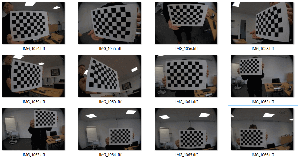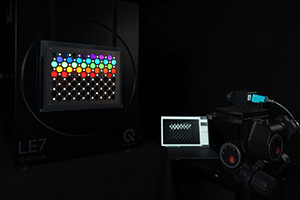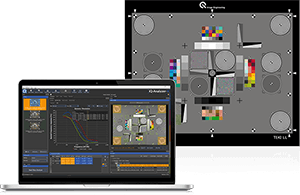Geometric Camera Calibration
Comparing various calibration methods

Geometric camera calibration is vital for systems that rely on detecting and accurately mapping 3D objects in a moving scene. After proper geometric calibration, the camera system will more precisely measure distances and identify objects in a scene. The system will also better adjust for high distortion levels and accurately align stereo camera pairs.
How do you ensure your systems are properly calibrated? There are traditional methods that involve a large test setup using multiple checkerboard targets. While this test method is adequate, it is not very efficient or convenient for labs that lack the space for a large setup.
Our solution to this challenge is GEOCAL, a compact geometric camera calibration device that uses a beam-expanded laser in combination with a diffractive optical element (DOE). GEOCAL can generate a light grid originating from infinity to improve calibration efficiency.
Check out our blog article, in which we compare the accuracy of GEOCAL to other currently established geometric calibration methods.
GEOCAL – Efficient Geometric Calibrations
Improving the efficiency and effectiveness of geometric calibrations

Proper geometric camera calibration is essential for systems tasked with detecting objects in a moving scene, e.g., ADAS applications. After calibration, the system more accurately detects and measures distances to objects in a scene. In addition, a calibrated system will be better equipped to compensate for high distortion levels and accurately align stereo camera pairs.
GEOCAL offers a compact geometric calibrations device that uses a beam expanded laser in combination with a diffractive optical element (DOE), creating a much more efficient calibration method than the traditional checkerboard method.
GEOCAL benefits:
- Ability to generate a regular grid of light spots originating from infinity
- Measure geometric distortion, focal length, and principal point
- The camera position is translation invariant (to a certain extent)
- Easily manage the angle of camera rotation
- A compact design and no relay lens required
- Calibrate large field-of-view cameras
- Stereo camera alignments and adjustments
- Remove lens distortion using GEOCAL and OpenCV
Advanced Camera Testing Services
Looking for camera testing help? – Check out our iQ-Lab

Are you familiar with our in-house camera test lab? The "iQ-Lab" offers a vast variety of camera test services and provides the opportunity to work closely with an independent and objective partner.
We work closely with companies to determine their testing requirements and find a testing solution that is the right fit. Whenever possible, we design our test methods after relevant international standards such as those from ISO, IEEE, and VCX. Many of our image quality test engineers are members of these standard working groups and contribute directly to the development of the standards, giving us firsthand knowledge of the outlined test methods.
In addition to the standard image quality tests that we offer, we also regularly perform more unique tests, including luminance and geometric calibrations, baseline evaluation, and conception and proof of concepts. Additionally, we offer temperature-controlled and even underwater testing.
Check out our website to learn more about the iQ-Lab.
Optimize your Image Quality Test Lab
Using multipurpose test charts for more efficient camera testing

A standard image quality evaluation typically involves assessing various image quality factors to determine a camera's overall performance. Factors such as camera resolution, texture loss, noise, dynamic range, color accuracy, and lens distortion have varying test specifications, requiring individual test targets.
Our multipurpose test charts combine multiple test targets on one chart plane. Instead of having numerous test charts, each with various targets for the image quality factor under test, our TE42 multipurpose test chart series enables you to evaluate multiple image quality factors in a single test image, significantly improving testing efficiency.
AI-Powered Test Target Detection
The iQ-Analyzer-X uses AI-powered tools for accurate target detection

iQ-Analyzer-X provides a high-speed analysis and improves testing efficiency by utilizing AI-powered tools to detect test targets accurately. iQ-Analyzer-X is compatible with our most popular test charts, such as our TE42 multipurpose series, where you can evaluate multiple image quality factors in one test image.
Other charts include the Universal Test Target (UTT), a multipurpose test chart for scanners, and our OECF grayscale target series, including TE297 and TE269C. Color charts, such as the TE188 ColorChecker and TE226 HDTV color rendition chart, can also be analyzed using the iQ-Analyzer-X.
Check out all of our iQ-Analyze-X compatible charts using the link below.
Are you new to the iQ-Analyzer-X? We offer a free download version of the software to start your image quality analysis today! Learn more about the free version and request your download on our website.

